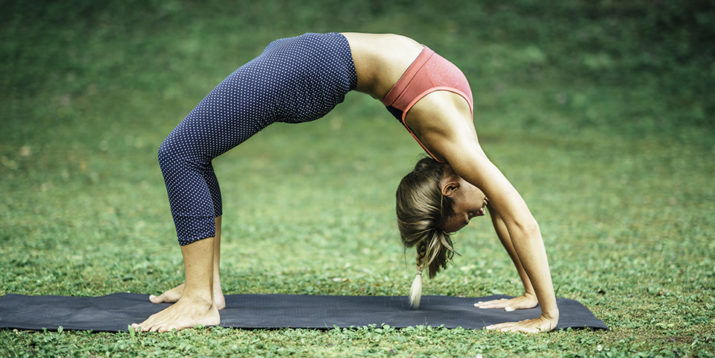How to Do Wheel Pose

Have you ever skipped wheel pose during a yoga class because you were afraid to try it?
Turns out, you’re not alone.
Full wheel pose is inherently a little scary, says Kino MacGregor, certified yoga instructor and co-founder of Miami Life Center.
“Not only does wheel pose require strength, flexibility, stamina, and determination, it also requires a heroic willingness to go to the scary places inside and face the sometimes paralyzing fear that surfaces the moment you try to bend over backward,” she says.
The fear elicited by the yoga wheel pose, MacGregor explains, is a (not always rational) response of the nervous system, but it is something you can work through—with patience, practice, and expert guidance.

How to Do Wheel Pose
There’s a reason full wheel pose usually appears in the second half of a yoga class: It requires a significant warm-up.
“Wheel pose is considered an advanced asana and is not a natural position for our bodies,” says Nathalia Basso, certified yoga instructor and founder of NathaliaFit. “Warming up the muscles and connective tissues is crucial in preventing injury.”
Once your body is adequately prepared, use Basso’s cues to find wheel pose:
- Lie on your back, bend your knees, and place the soles of your feet on the ground about hip-distance apart. Draw your heels close to your glutes.
- Reach your arms overhead and place your palms on the ground next to your ears so that your fingertips are facing your shoulders.
- Inhale. On your exhale, press your hands and feet into the floor. Raise your lower body first, lifting the pubic bone toward the navel, then the upper body.
- Straighten your arms. Keep your feet and knees parallel; don’t allow them to splay apart.
- In the fullest expression of wheel pose, allow your head to fall back.
Yoga Wheel Pose Modifications
Like nearly every yoga pose, full wheel pose can be modified to suit your needs and experience level, whether you’re a beginner or an advanced practitioner.
Wheel Pose for Beginners
Lara Heimann, physical therapist, certified yoga instructor, and creator of the LYT Yoga method, suggests establishing a stable bridge pose before attempting wheel pose.
- Set up as you would for wheel pose: lie on your back with your arms at your sides, bend your knees, and place the soles of your feet on the ground about hip-distance apart. Draw your heels close to your glutes.
- Keeping your head, shoulders, and arms on the ground, use your glutes to lift your hips toward the ceiling. “You always want your glutes firing for backbends, no matter what you might have been told or read,” Heimann says.
Once you feel strong in bridge pose, you can progress to a wheel-pose modification that works shoulder mobility and thoracic extension.
- Set up for wheel pose with your head close to a wall. Position two yoga blocks against the wall.
- As you reach your arms overhead, place your palms on the yoga blocks (instead of the ground).
- Lift your hips into bridge pose, then press your hands into the blocks and attempt to lift your head off of the floor.
“The blocks make it a bit easier for the shoulder opening, but you still might have to work on the required strength to push up,” Heimann says.
How to Make Wheel Pose Harder
If you feel strong and comfortable in the yoga wheel pose, there are a few ways to make it more challenging.
- “See if you can walk your hands closer to your feet while keeping the heels firmly planted on the ground, without compromising the structural integrity of the posture or the stability through your legs,” MacGregor suggests.
- You can also lift your heels or attempt to lift one leg or arm while in wheel pose. Or, try to grab your calf with one hand while holding wheel pose.
- “You can also lower your forearms to the floor for a greater opening in the shoulders and chest,” says Heimann.
Benefits of The Wheel Pose
The benefits of wheel pose range from physical to emotional and mental. Known to help spark creativity, wheel pose opens the chest, also known as the heart chakra, “which can be both relieving and emotionally intense for some,” says Basso.
Adam Binder, certified yoga instructor and founder of Apeiron Yoga, explains the physiology behind this effect.
“Your posture while in wheel pose stimulates the thyroid and pituitary gland, which is said to energize you while preventing anxiety and stress,” he explains.
The purely physical benefits of wheel pose are also notable.
Doing full wheel pose is a great way to strengthen nearly every muscle in your body while getting a great stretch.
“Wheel pose strengthens the upper body, including the arms, shoulders, and upper back, as well as the legs and glutes,” says Basso. “Wheel pose also stretches the muscles of the frontal plane, including hip flexors, abdomen, chest, neck, and shoulders.”
This deep stretch that wheel pose offers can help balance out the hours many people spend sitting in front of a computer or slouched over a phone.
